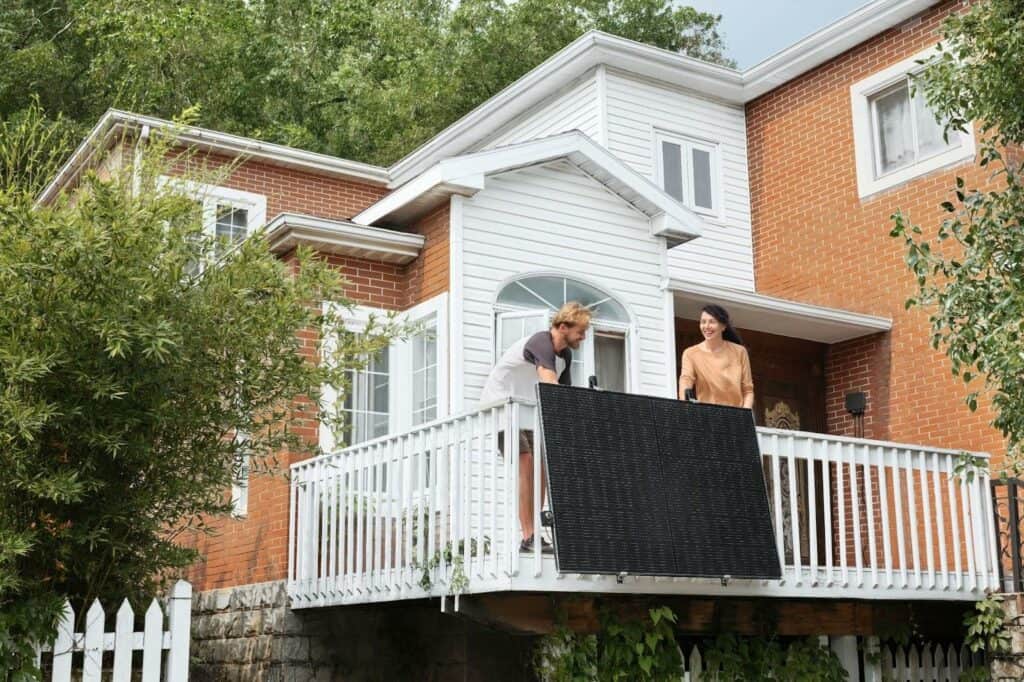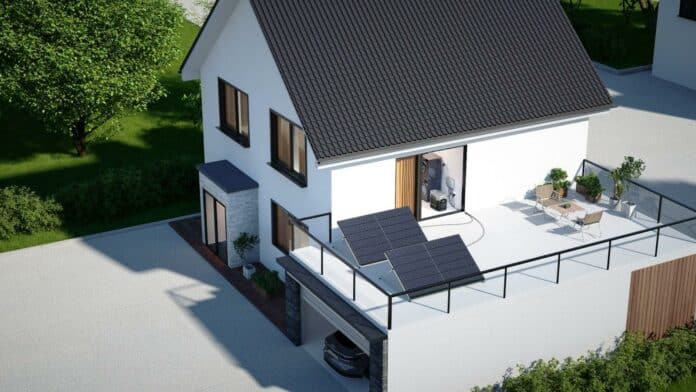Table of Contents
Purchasing a residential solar panel system requires a substantial investment.
But it can pay off in a big way.
By purchasing high-efficiency solar panels — and optimizing your installation — you can get a substantial return on investment.
One crucial but often underestimated factor in maximizing your solar ROI is positioning your PV panels correctly.
Here’s how.
Which Direction is Best for Solar Panels?
The ideal direction for solar panels varies based on your geographical location.
When you’re installing PV panels in the Northern Hemisphere, you’ll want them facing true south to get maximum peak sunlight during the day. For homes in the Southern Hemisphere, it should be facing true north.
As the sun rises in the east and sets in the west, installing panels facing either west or east means they’ll receive less sunlight and, thus, produce less energy.
True south isn’t the same as magnetic south; its orientation depends on the sun’s location rather than Earth’s magnetic field. Magnetic declination refers to the difference between these two.
To optimize sunlight capture, consider rotating your panels to face southwest later in the day or use a solar tracker. By facing southwest for a portion of the day, your panels will produce more electricity light while the sun sets. Perfect timing because household electricity consumption typically increases in the late afternoon and evenings.
What Is the Best Angle for Solar Panels?
The direction your panels face isn’t the only thing you need to consider when installing solar panels.
To optimize your power output, you also need to consider tilt.
To find the optimal angle for your location, you must take into account numerous factors that might interfere with your panels’ ability to collect sunlight.
The angle of your PV panels has a significant impact on performance, but it’s not as crucial as direction. To optimize sunlight capture, get the direction right first. Then, drill down on calculating the optimal angle for your installation.
How Do You Calculate the Best Angle for Solar Panels?
Calculating the optimal angle for your solar panel installation allows you to maximize electricity generation and enjoy the benefits of sustainable energy for years to come!
Your home’s geographical latitude is essential to determining the optimal angle for your solar panels.
If you live near the equator, you won’t experience significant variation in seasonal sunlight exposure throughout the year.
The further your distance from the equator, the more the significance of geographical latitude grows.
Latitude impacts the amount of sunlight that reaches the panels, depending on their position in relation to your location and the rotation of the Earth around the sun.
In the middle of the day during summertime, your panels should ideally point directly at the sun. An excellent method to optimize your panels’ vertical tilt is to position them at an angle slightly greater than or equal to your latitude.
For example, if you live 40 degrees north of the equator, your panels should be installed at a 40-degree angle from horizontal.
You should note that using this method makes your solar array marginally less effective during the winter when the sun will be lower in the sky. For this reason, some people tilt panels at an angle somewhere between their latitude and their latitude plus 15 degrees. This helps optimize electricity production year-round.
If you’re unsure of your latitude, here’s a handy resource to help you find out.

Does Solar Panel Direction or Angle Matter More?
While the tilt angle of your solar panel certainly plays a role in electricity output, it’s essential that your array faces the right direction. For the best results, you should prioritize solar panel direction over solar panel angle.
The best way to do this is to get the direction right first, and then calculate the optimal angle.
What Other Factors Affect Solar Panel Orientation?
Here are the additional factors that impact the optimal orientation of your solar panels.
Roof Design and Panel Placement
Panel placement is essential to maximizing power output.
If you install roof-mounted PV panels, your home’s design will significantly impact your solar array’s performance.
It’s crucial to consider the tilt and layout of your roof before you install your panels.
If your roof is built at a steep angle, you may not be able to achieve the optimal angle for your solar panel installation using a traditional racking system. You might want your panels lying flat against your roof in such instances.
Solar panel arrays on low-angled roofs or areas shaded by trees or buildings won’t produce as much electricity as PV panels mounted where they get hit with direct sunlight all day long.
If you don’t have an unshaded area on your roof, you could consider specialized mounting – but this may limit the amount of panels you can install.
By placing your solar panels on the ground, the incline and terrain play a role in the power production potential of your solar panel.
However, ground-mounted panels have their benefits. They’re easier to clean and maintain than roof-mounted panels. If you use portable solar panels, you can even manually adjust the angle over the course of the day to maximize sunlight capture.
Time of Year and Weather Conditions
The time of year and weather conditions also impact the ideal tilt for your panels.
If clouds block sunlight for extended periods, it may help to tilt your panels away from the equator slightly. This allows them to collect energy when overcast conditions are prevalent.
The further south or north you are from the equator, the lower the sun will be during the winter months. For optimal production, your panels should ideally be inclined differently depending on the time of year. Not all mounting systems allow this. You may want to consider one that does.
Installing solar panels at a steeper angle than the latitude of your location can assist in counteracting dips in production during the winter. You’ll also want to ensure that the tilt allows snow to slide off the panels easily if it snows in your area.
Going too steep, however, will reduce the amount of light that hits your solar cells and increase shading from obstacles like trees. On the other hand, having your panels perpendicular to the ground isn’t ideal either due to the buildup of snow.
Frequently Asked Questions
In most cases, electricity output won’t be significantly impacted by facing your panels east or west. However, for those in states or provinces with Time-of-Use pricing for electricity, having solar panels facing west can result in savings during peak hours.
Final Thoughts
There are many factors to consider regarding the direction and angle to orient your solar panels, but it pays to get it right.
Installing your solar panels at the optimal direction and angle will shorten your solar payback period and maximize your return on investment.
EcoFlow offers mountable and portable solar panels with industry-leading efficiency. Check them out today and get the most bang for your solar buck.
